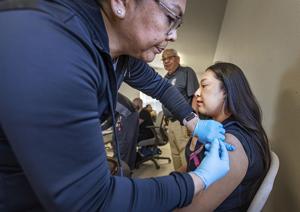Health
New Mexico Plans to Allocate $50 Billion for Rural Health Care

The New Mexico Health Care Authority is preparing to apply for a share of the **$50 billion** available through the newly established **Rural Health Transformation Program**. This initiative, part of the recent federal budget reconciliation law signed by **President Donald Trump** in July, aims to enhance rural health care services across the United States. The application deadline for the funding is set for **November 5, 2024**, with a significant emphasis on incorporating public feedback.
During a public forum attended by over **250 health care professionals**, including doctors, paramedics, and hospital CEOs, participants voiced their priorities for the funding. Key suggestions included expanding behavioral health services, enhancing resources for mobile and telehealth solutions, and improving recruitment and retention strategies for health care workers. According to **Dana Flannery**, New Mexico’s Medicaid Director, much of the feedback aligns with the agency’s existing goals.
Funding Challenges and Opportunities
The federal budget reconciliation law includes provisions aimed at reducing expenditures, particularly in Medicaid and food assistance programs. As a consequence, the New Mexico Health Care Authority has projected that the cuts could lead to the closure of **six to eight** rural hospitals in the state by **2028**. The **Rural Health Transformation Program** is specifically designed to address these concerns by providing substantial funding over a five-year period.
The allocation of the **$50 billion** is divided into two parts: **$25 billion** will be evenly distributed among all states, while the remaining **$25 billion** will be awarded based on state applications. New Mexico’s Health Care Authority is preparing to submit its application for a portion of this funding, though preliminary analyses indicate that the assistance may only cover **37%** of the anticipated losses from Medicaid cuts in rural areas.
Addressing Workforce Needs
At the forum, health care professionals highlighted the urgent need for a larger workforce across various specializations. While cities like **Albuquerque** and **Santa Fe** have access to specialists such as pediatricians and cardiologists, rural regions often struggle to attract these professionals. Dr. Larry Shandler, representing the **New Mexico Pediatric Society**, emphasized the importance of increasing Medicaid reimbursement rates to improve access to care.
In recent efforts, the state has already implemented rate increases for behavioral health, primary care, and maternal and child health services. “We’re seeing a decrease in health services in rural areas,” Shandler noted, advocating for a stronger telehealth infrastructure to mitigate these challenges.
Yet, some professionals cautioned against an overreliance on telehealth due to existing internet access issues. The **Federal Communications Commission** reported that about **10%** of addresses in New Mexico were classified as underserved or unserved in **2024**. The need for mobile medical resources, including paramedicine and mobile health clinics, was also underscored, with **Faith Applewhite**, a Santa Fe paramedic, stating, “We can really be the boots on the ground to deliver that health care.”
As the New Mexico Health Care Authority finalizes its application, Flannery is optimistic about securing the necessary funding. “Let’s apply and have a very competitive application so that we can bring home this opportunity,” she said, reflecting the collective hope for improved health care services in the state.
-

 Business4 days ago
Business4 days agoInvestors Eye Potential $60,000 Gains with Ozak AI Token
-

 Business5 days ago
Business5 days agoQuotient Wealth Partners Adjusts Holdings in iShares Russell 1000 ETF
-

 Politics5 days ago
Politics5 days agoFormer Pastor Arrested on Human Trafficking and Indecent Charges
-

 Politics4 days ago
Politics4 days agoSkip Bayless Critiques Travis Hunter’s Game Day Baptism
-

 Entertainment6 days ago
Entertainment6 days agoUtah Residents Face Resource Shortages Amid Ongoing Government Shutdown
-

 Business6 days ago
Business6 days agoCalifornia to Ban All Plastic Bags in Grocery Stores by 2026
-

 Lifestyle5 days ago
Lifestyle5 days agoNatty from KISS OF LIFE Stuns in Micro-Shorts at Seoul Event
-

 Science5 days ago
Science5 days agoCommunity Mourns Loss of Judith Ernst, Pioneer Educator at 81
-

 Entertainment6 days ago
Entertainment6 days agoEastside Kings Festival Celebrates Austin’s Rich Blues and Jazz Heritage
-

 Entertainment5 days ago
Entertainment5 days agoPete Davidson Surprises Pregnant Girlfriend with Private Jet to Concert
-

 Entertainment5 days ago
Entertainment5 days agoAce Frehley, KISS Guitarist, Passes Away at 74 After Fall
-

 Politics5 days ago
Politics5 days agoIberia Parish Sees Surge in Marriage Licenses Issued in October









